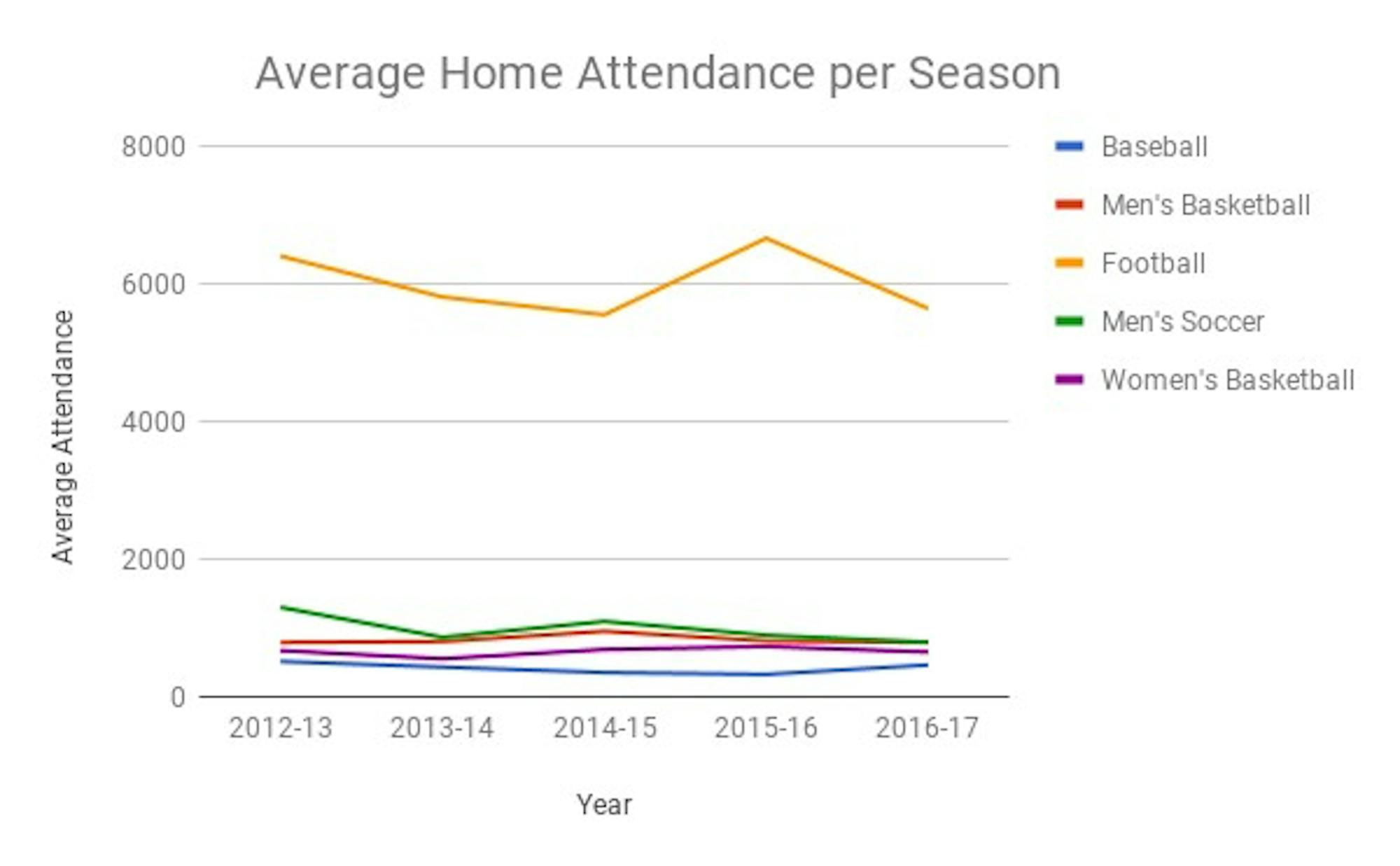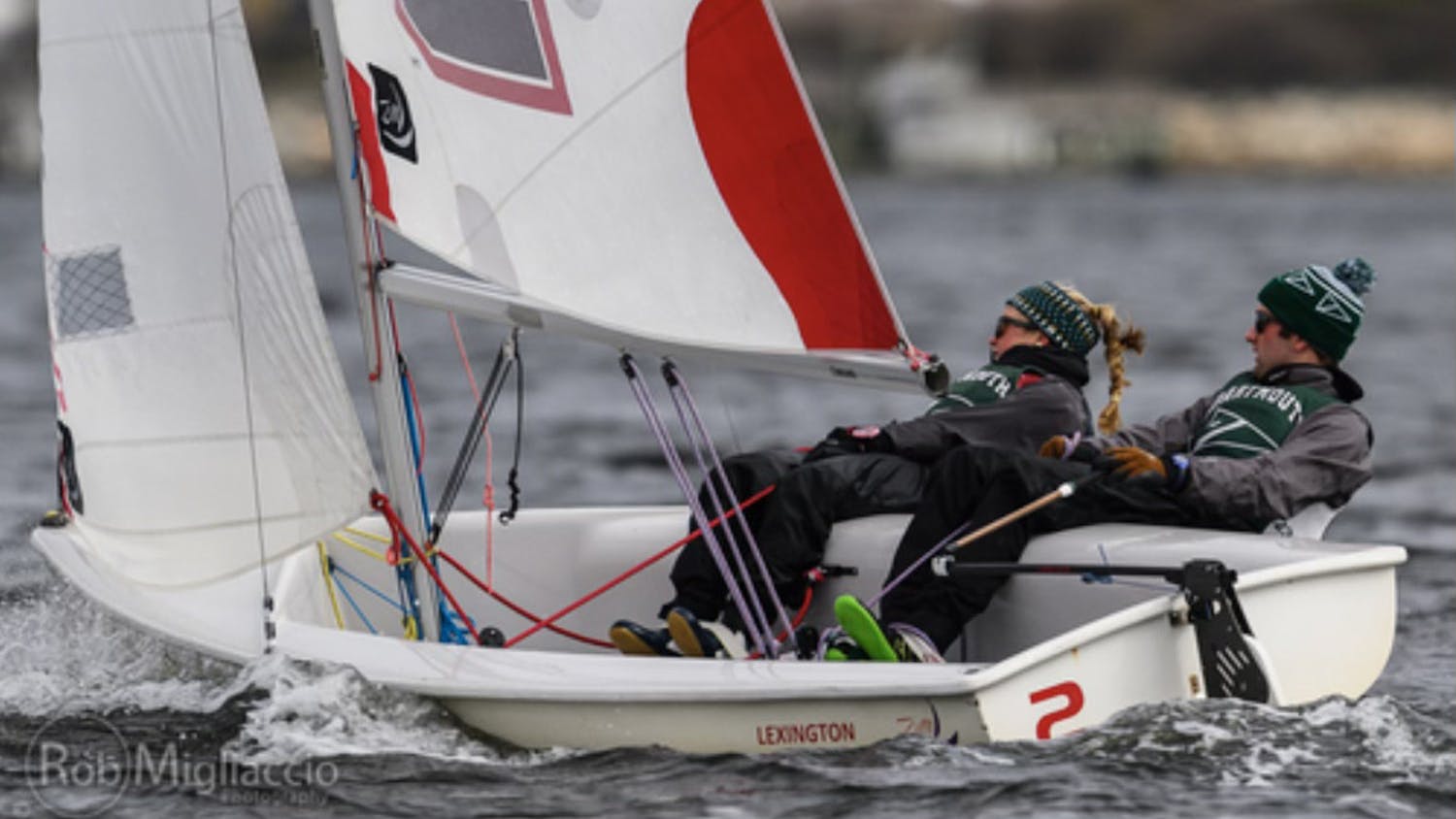When thinking about sports, some people typically consider different games, matches and meets and the many rules associated with the sport. Others may think about their own experience as an athlete and the fond memories associated with it. Still, some may think about their favorite teams and athletes. Although these are vital components of sports, the unsung heroes in athletics are the fans. Fans are a crucial part of games as they have the ability to rally behind teams after a challenging defeat or advocate for them in their biggest triumphs.
With fans maintaining such an important role to their teams, promoters and marketing teams consistently work to maintain fan support throughout the season. To do this, however, they must begin by looking at the trends in attendance.
According to Dartmouth athletics department’s press box data from year to year for 13 ticketed sports, the most well-attended sports at Dartmouth are football and men’s hockey. Men’s soccer comes in at a distant third. Football’s lead isn’t much of a surprise, as there are only five or six home games in a typical season, and there is more of a “game-day” atmosphere associated with the sport.
Laura Sgrecci, the assistant athletic director for marketing for the Dartmouth athletic department, described some of the trends she has noticed at Dartmouth athletic events throughout the years, including increased attendance with better team performances.
“Naturally, you see our attendance trend with the performance of our teams,” Sgrecci said. “Men’s soccer is a great example [with] four Ivy League titles in four years, their attendance overall and amongst students has been pretty strong. Something that I’ve noticed contributing to that is that they have a lot of friends on campus and their fraternity comes out in force to all their home matches, and is vocal and has a great impact on the game and on the atmosphere.”
In 2015, the football team won a share of the Ivy League title, winning every one of its five home games. The average attendance of home football games that season was 6,660 people, a jump from 5,549 people on average in 2014. Likewise, in the 2012 men’s soccer season, Dartmouth won six of its seven home games, with an average attendance of 1,300 people, higher than the overall average attendance over the last five years of around 990 people. The last game of the season also saw the highest-attended game in the last four years at 2,100 people. That game against Brown University had Ivy League title implications, so the Dartmouth community came out in force to support its team, and it paid off as the team came away with an overtime victory.
Men’s basketball’s Ian Sistare ’20 stressed the impact that a home crowd can have on the energy of a team.
“We have had a few games this year when our home crowd really helped us out in terms of energy and enthusiasm,” Sistare said. “A great home crowd gives the players and the coaches such a boost in terms of energy and enthusiasm. [It] makes the game so much more exciting and the atmosphere is so much better when the crowd is wild.”
While football, men’s hockey and men’s soccer do not need much help in attracting fans to their events, some sports that may have venues further away from campus have trouble attracting fans to their events. Sports that are not ticketed also have to use their own resources to get fans to their events.
“There have been situations, such as rugby and skiing, where we will work with the teams, if they want to use their own resources to try to get fans to their games,” Sgrecci said. “I’m happy to work with them to come up with ideas. In terms of the distance to get to rugby and skiing, we have worked with our administration and the teams budget to work out a shuttle to get to big games.”
Because of the home competition site’s distance from campus, the equestrian team usually has a core fan base of friends and family.
“We are six miles from campus, and it’s not easy to get there [because] it’s up a mountain,” equestrian head coach Sally Batton said. “So any fan attendance that we have are friends of members on our equestrian team.”
Equestrian also has a more intimate atmosphere that comes with the smaller size of the fan base.
“I would say compared to like a hockey game where you may or may not know the hockey players, [it’s more personal] because it’s friends of the athletes,” Batton said. “So in the past they’ve made funny signs related to horse terms. Signs would say, ‘Jane you’re galloping into our hearts.’ Something funny. So for me it’s really entertaining. And then I generally hang onto the signs, and I hang them in our locker room so we can look at them.”
Batton echoed Sistare’s statement about fans boosting the team morale.
“I think that [the support] does really boost the morale of the athletes,” Batton said. “Also I think having the signs and the people cheering for them it makes them feel like the other varsity athletes. When you play a team sport you’re used to having a lot of people around you cheering and you take it for granted. And so equestrian tends to be quiet like golf in order to not spook the horses. So it’s great that you can have people cheering for you. It’s fun to have the atmosphere.”
In recent years, Dartmouth’s athletic department has started multiple initiatives to get Dartmouth students and residents of the Upper Valley to come to athletic events.
“We’ve done focus groups with students and student athletes to try to understand what incentivizes and what drives students to go to games and what incentivizes student athletes to get excited to go to their fellow student athletes’ games,” Sgrecci said. “And so I’ve met with the Programming Board and other organizations like that to try to gain more insight and information as to student behavior, and given everything they have going on, what really is going to compel them to go to an athletic contest. So, we kind of base our path and our behavior on those learnings.”
Sgrecci noted giveaways are one of the more common initiatives the Dartmouth athletics department takes.
“[We give away] hats, scarves [and] things ... that I tend to hear are popular, something that [spectators] can wear at a game or in the winter since it’s practically winter throughout the year,” Sgrecci said.
The giveaways are not limited to clothing items.
“We’ve heard that food sometimes can be popular, so we’ve done mac and cheese night at a hockey game last year,” Sgrecci said. “We’ve done tailgates, you know, typical barbecues at football and soccer games.”
One of the major new initiatives was the development of the Big Green Rewards app.
“[The app is] something that a few other Ivies are doing and after doing some focus groups this summer, we as a department decided to give it a try starting late summer, early fall,” Sgrecci said. “The app is for all Dartmouth students, and it’s aimed at increasing student attendance at all of our events so it includes all 35 of our varsity sports.”
The app is similar to the polling platform College Pulse in that it gives students points for attending athletic events and rewards those students with prizes once they’ve reached a certain threshold.
“The app is based on the locations services of your phone,” Sgrecci said. “It lists all of the events and once it’s within the game time, say it’s a 7:00 [p.m.] basketball game, and you’re in the radius for it and it can tell that you’re in the venue, you’re able to hit ‘check in.’ It rewards you, and it gives you points for every event that you go to, and then at certain thresholds there are prizes that you can win.”
With over 600 registered students, Sgrecci views the app as a success so far.
In addition, Sgrecci incorporated an extra student-athlete component into the app to encourage student-athletes to attend their fellow student-athletes’ events.
“[The app] includes a competition amongst our teams so that at the end of the academic year the team that accumulates the most points based on their roster size, basically the team that’s been the most supportive of their student-athletes, wins a trophy,” Sgrecci said. “[So far] women’s basketball is leading the pack.”
In order to further increase the number of students registered on the app, Sgrecci plans to promote the app during Orientation.
Another initiative that has taken place in the past week has been the “flannel night” at the men’s basketball game against Princeton University on Feb. 10.
“At some point last year I discovered that [Feb. 10] was national flannel day and so going into this fall when we were looking at the winter sports schedule I saw that men’s basketball had a home game on [Feb. 10] so we decided let’s go for it,” Sgrecci said. “Also last year we had started getting in touch with Guinness World Records to find out what was an appropriate record involving flannel, that we could tie into this. [We] found [out] about this interesting record about the largest gathering of people wearing tartan, and we were pleased to find out that it was a number [1,146] that we could hit based on the capacity of Leede Arena, a crowd size that we have certainly drawn.”
When planning the event, an important distinction had to be made between “flannel” and “tartan” — tartan is the plaid pattern, and flannel is the material used to make the shirts. The record also specified that each person had to be wearing two tartan articles of clothing, one top or bottom and one accessory.
The coaching staff joined in the festivities as well, promoting the event by wearing tartan of their own.
“We brainstormed how we could get the team and the coaching staff involved,” Sgrecci said. “Obviously the team isn’t able to wear tartan or flannel, but we [asked] the coaches [if they were] willing to wear tartan ties.”
Unfortunately, the fans didn’t break the record, but the game was extremely well attended.
“I think our announced attendance that night was 1,396.” Sgrecci said. “We’ve had two sellouts for basketball this season, against [the University of Vermont] and Harvard [University] and then this was a near sellout at 1,396. So, we felt like it was a success in terms of driving attendance to a meaningful game. We consider it a success from a marketing standpoint and we are planning on making this an annual thing.”
The men’s basketball players seemed to view the initiative as a success as well. They were certainly appreciative of the fans as the team pulled out its first Ivy League win of the season against Princeton that night.
“The flannel game was fantastic,” Sistare said. “We had a great turnout. [There were] lots of flannels in the crowd which was great. I think we fell a little short of the world record, but it was a great crowd that night and it energized our team and helped us pull the win out.”
While attendance at Dartmouth athletic events may not always be as high as it could be, efforts are certainly being made to increase the number of Dartmouth students and members of the greater Dartmouth community who support the Big Green.




